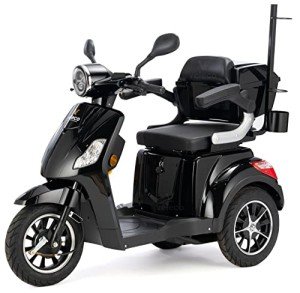“Ask Me Anything:10 Responses To Your Questions About Buying Mobility Scooter
A Comprehensive Guide to Buying a Mobility Scooter
Mobility scooters have ended up being a crucial tool for numerous individuals aiming to boost their self-reliance and mobility. With a large range of designs and features available, choosing the right mobility scooter can be daunting. This post supplies an informative guide to assist customers browse their alternatives, examine their requirements, and make an informed purchase.
Comprehending Mobility Scooters
Mobility scooters are electric cars designed for people who experience mobility difficulties. They are particularly advantageous for seniors, those with impairments, or individuals recuperating from injuries. Mobility scooters can differ widely in regards to design, functions, and rates.
Kinds Of Mobility Scooters
Before starting a purchase, it's important to understand the different types of mobility scooters available:
Three-Wheel Scooters:
- Generally more maneuverable in tight spaces
- Lightweight and portable
- Suitable for indoor usage
Four-Wheel Scooters:
- Offer higher stability and balance
- Suitable for outdoor usage over various terrains
- Usually have a longer battery life
Foldable/Portable Scooters:
- Designed to be easily carried and saved
- Can often fit in the trunk of a cars and truck
- Perfect for those who take a trip frequently
Heavy-Duty Scooters:
- Built to accommodate bigger people
- Frequently included more robust features for outside usage
- Typically equipped with bigger batteries for extended range
Factors to Consider When Buying a Mobility Scooter
1. Weight Capacity
Choose a mobility scooter that can support the user's weight. Most scooters have a weight limit varying from 250 to 500 pounds. It is vital to guarantee that the scooter can accommodate the user conveniently.
2. Range and Battery Life
The range is how far the mobility scooter can take a trip on a single charge. Common varieties differ in between 10 to 30 miles. Consider the user's everyday activities and choose a scooter with an appropriate range.
3. Scooter Dimensions
Think about the size of the scooter, including its weight and dimensions. A more compact scooter may be ideal for narrow hallways and tight spaces, while bigger designs offer extra stability and comfort.
4. Surface Capability
Examine where the scooter will primarily be used. If the user prepares to take a trip mostly on pavement, a lightweight model may be enough. However, if the user requires to pass through gravel or uneven surface areas, think about a four-wheel scooter developed for off-road use.
Top Features to Look For
Convenience
- Adjustable Seats: Look for scooters with cushioned and height-adjustable seats to ensure convenience during travel.
- Armrests: These enhance security and support while navigating.
Safety and Visibility
- Headlights and Taillights: Essential for nighttime use.
- Turn Signals and Reflectors: Improve visibility and safety while on the road.
User-Friendly Controls
- Joystick or Drive Controls: These ought to be intuitive and easy to manipulate.
- Easy-to-Read Displays: A control board that shows battery life, speed, and distance can boost the user experience.
Extra Features
- Storage Compartments: These provide included convenience for carrying individual items while on the go.
- Weather condition Protection: Consider models with rain covers or windscreens if used in variable weather.
Expense Considerations
When budgeting for a mobility scooter, rates can range anywhere from ₤ 500 to over ₤ 5,000 depending on the design, functions, and brand. Extra expenses may consist of:
- Extended Warranty: Protects versus defects and can save cash in the long run.
- Accessories: Optional functions, such as updated seats, lights, or storage solutions.
Function
Expense Range
Basic Models
₤ 500 – ₤ 1,500
Mid-Range Models
₤ 1,500 – ₤ 3,000
High-End Models
₤ 3,000 – ₤ 5,000
Funding Options
Lots of retailers offer funding plans, and some local government efforts might offer grants or help for those in need. Examine prospective financial help with neighborhood resources or mobility service companies.
FAQs about Buying a Mobility Scooter
What is the distinction between a mobility scooter and a wheelchair?
Mobility scooters are motorized and allow users to navigate independently, while wheelchairs might need physical support or manual operation.
How do I preserve a mobility scooter?
Routine maintenance includes checking battery life, cleaning up the scooter, and checking tires and brakes. Always describe the user manual for particular standards.
Can mobility scooters be utilized inside?
Yes, lots of models are developed for both indoor and outdoor use. However, mobility scooter for sale -wheel scooters tend to be much better matched for indoor navigation due to their tighter turning radius.
Are mobility scooters covered by insurance coverage?
Some insurance prepares cover a portion of the expenses for mobility scooters if they are deemed medically required. Contact your supplier for specific information.
How quick can a mobility scooter go?
The majority of mobility scooters have an optimal speed ranging from 4 to 8 mph. Nevertheless, the suitable speed might differ depending on regional policies.
Buying a mobility scooter can considerably improve one's independence and quality of life. By comprehending the types, functions, and expenses related to mobility scooters, prospective buyers can make knowledgeable decisions that suit their requirements and preferences. Personalization and thorough research study are crucial to making sure complete satisfaction with this essential investment.
